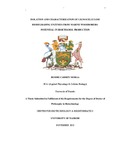| dc.description.abstract | Marine woodborers are members of phylum Mollusca, class bivalvia, families Teredinidae and Pholadidae; and phylum Arthropoda, class crustacea, family Sphaeromatidae. They have a close association with tropical mangrove habitats where they consume lignocellulose and play a role in nutrient cycling. They represent a rich source of lignocellulolytic enzymes that can be harnessed for conversion of biomass into simple sugars and other monomers for a variety of uses including bioethanol production.
Enzymatic degradation of lignocellulose has emerged as the most prominent technology for conversion of biomass into monomer sugars for subsequent fermentation into bioethanol. This is an ideal approach for degrading cellulose because of its mild reaction conditions (pH between 4.8–5.0 and temperature between 45–50
°C), it does not present corrosion problems in the reactors and results in high sugar yields.
This study isolated lignocellulolytic enzymes from marine woodborers in the Kenyan coast, investigated their potential in bioethanol production and characterized the enzyme with highest activity.
Three species of woodborers from marine mangrove plants were identified and relations between them and the host mangrove plants (Avicennia, Sonneratia, Rhizophora) described. Marine woodborers Dicyathifer mannii (Wright, 1866), Sphaeroma terebrans (Bate, 1866) and Cirolana sp. occur on submerged parts of roots (proproots, pneumatophores), stems and branches. D. mannii was found mostly on Rhizophora but also on Sonneratia, whereas S. terebrans and Cirolana sp. were found exclusively on Avicennia.
Crude gut extracts were obtained from D. mannii and S. terebrans (Cirolana sp. were not obtained in enough numbers for crude gut extraction). These were tested for lignocellulolytic activity. D. mannii crude extracts showed an appreciable endoglucanase (CMCase) activity of up to 50.7 ± 1.51 U/ml , xylanase activity of
35.52 ± 1.54 U/ml and Lip activity of up to 34.65 ± 0.12 U/L (1 U represents 1 micromol of glucose released min-1). D. mannii is implicated as a source of these enzymes for industrial use.
To determine the bacterial and fungal diversity within the woodborers’ digestive tracts, bacteria and fungi from the digestive tracts of D. mannii, S. terebrans and a Cirolana sp. were cultured and investigated. The bacteria and fungi were identified by sequencing the fragments of 16S rRNA and ITS gene respectively, with subsequent phylogenetic analysis. Four strains, Lysinibacillus boronitolerans (from D. mannii and S. terebrans), L. fusiformis (from S. terebrans and Cirolana sp.), L. sphaericus and L. xylanilyticus (both from Cirolana sp.) had similarity to known 16S rRNA sequences of
98–99 %.
Various strains of Ascomycetes fungi were identified from the digestive tracts of the woodborers. Aspergillus niger was isolated from the digestive tracts of both D.mannii and S. terebrans. In addition, Neosartorya fischeri and A. fumigatus were present in D. mannii whereas Botryotinia fuckeliana was found in S. terebrans digestive tract. A. costaricaensis and A. fumigatus were present in Cirolana sp. while Penicillium sp. was isolated from D.manni and Cirolana sp. digestive tract. The fungi had similarity to known ITS sequences of 95–100 %. Existence of bacterial and fungal groupings symbiotically associated with woodborers gut is proposed.
Pure bacterial and fungal isolates from each of the woodborers as well as mixed cultures for each woodborer were induced to produce lignocellulolytic enzymes. Substrates used for induction were carboxymethylcellulose sodium salt (CMC), Whatson No. 1 filter paper (FP), beechwood xylan, Rhizophora wood dust, D (+)- cellobiose and avicel cellulose. While there was generally low ligninolytic activity in both bacterial and fungal isolates, cellulolytic and hemicellulolytic activity was significantly high in both pure bacterial and fungal isolates as well as in mixed cultures. The highest bacterial enzyme activity was β-glucosidase (94.55 U/ml) shown by L. boronitolerans from S. terebrans cultured in a medium containing avicel cellulose as a carbon source. In contrast, xylanase activity was highly exhibited (up to
91.7 U/ml) by L. xylanilyticus from Cirolana sp. in medium containing cellobiose. The highest fungal activity was β-glucosidase (54.77 U/ml) shown by A. niger from D. mannii gut in a medium with mixed sudstrates. Wood, FP and CMC did not sufficiently induce production of β-glucosidase by the fungal isolates. CMCase production was significantly induced by xylan beechwood substrate.
Since D. mannii had shown to have the most lignocellulolytic efficacious extracts, the ability of the culture filtrate of its gut microbial community to biodegrade wheat straw into fermentable sugars for ethanol production was investigated. 24 hours fermentations by 0.3 % Saccharomyces cerevisiae of 3 % wheat straw degradation reaction mixture with D. mannii gut microbial filtrate (previously incubated for 1 hour
at 50 0C in 0.1M sodium acetate buffer, pH 5.0) yielded 0.98 mg/100ml supernatant.
The highest D. mannii microbial community lignocellulolytic activity was xylanase. Consequently, xylanase from the culture filtrate of D.mannii gut microbial community was isolated and purified. The purified enzyme showed a single band on SDS polyacrylamide gel electrophoresis (SDS-PAGE) with an apparent molecular weight
of ≈ 20 kDa. The enzyme was moderately thermostable with optimum activity at 50 °C
and pH 5.0. It had a high affinity for xylan beechwood with Km and Vmax values of 0.4
% (w/v) and 128.2 µm ml-1 min-1, respectively. This is the first report on production, purification and characterization of xylanase from D.mannii gut microbial community. | en_US |


